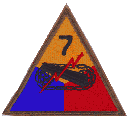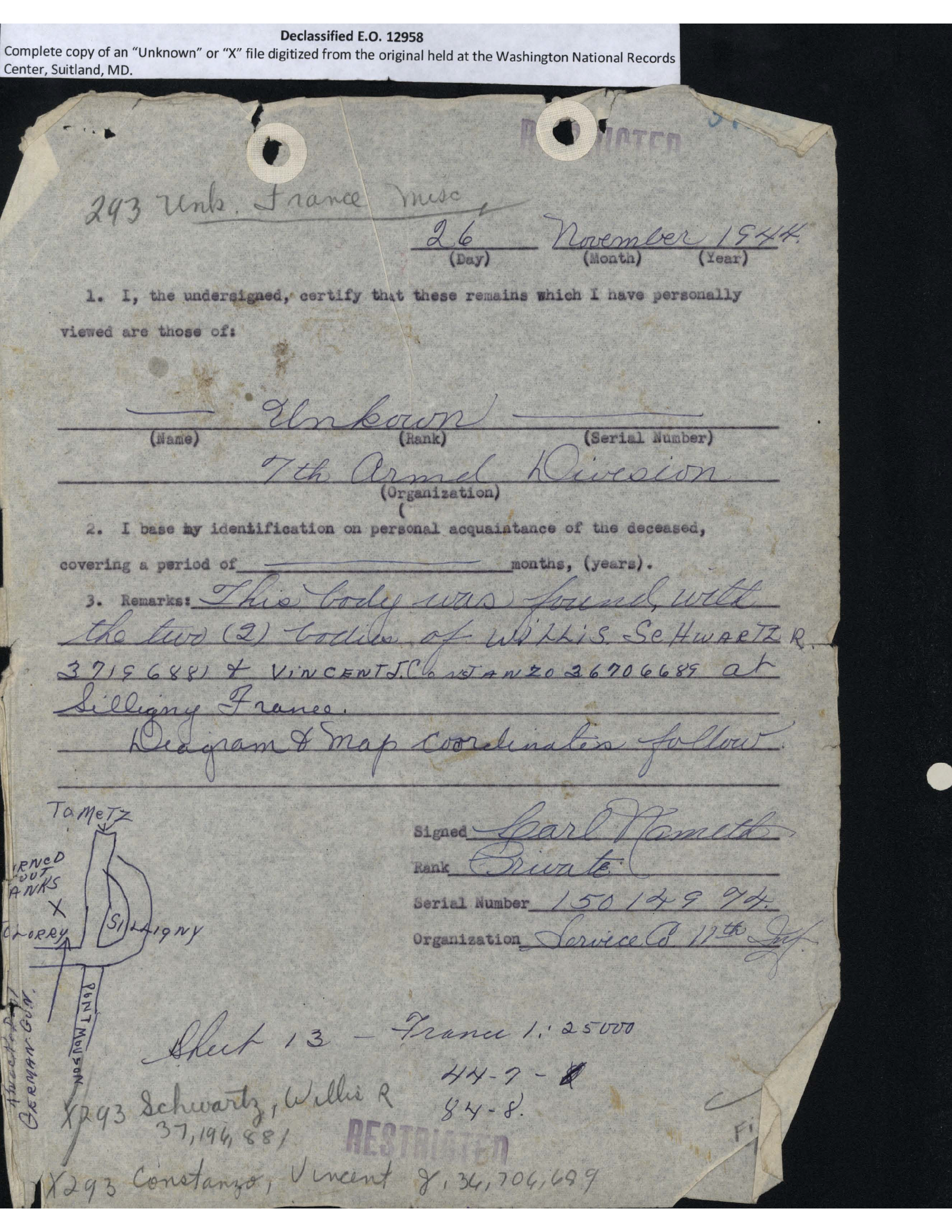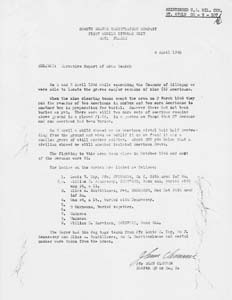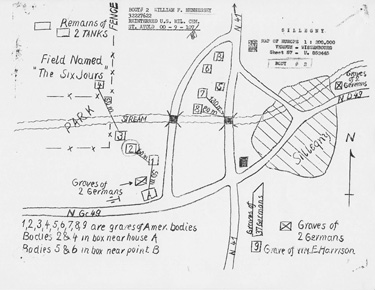
Click here for web page of all still-MIA 7AD men.

|
Elements of the 7th Armored Division first attacked Sillegny, France, on the afternoon of 18 September 1944. In the early hours of 19 September 1944, they launched a series of attacks, attempting to reach and cross the Seille River just east of the village. Sillegny is a quiet little village, blessed with one of the few French churches with Italian frescoes. But for several days, it was Hell on Earth. The Germans had evacutated the civilian population, and they had built a pill box at the road junction southeast of town. The pillbox provided direct fire on the only road into town from the forest about 2 kilometers to the west. The 7AD troops dug in at the east edge of the forest. There was nothing but flat, downward sloping open ground -- completely exposed -- between the forest and the village. The Germans heavily mined the field north of the road, the field called the Field of Six Days (Le Champ des Six Jours). Many of the men who fell in that field remained there until the area was de-mined in 1946. The 7th Armored Division continued to press the attacks to reach the Seille for several days. But the Division was needed in the Netherlands to bolster the east flank of the salient created by Operation Market Garden, so that the Division withdrew west of the Moselle and then on 25 September began the march north to the Netherlands. The Division left behind many who had been killed but not recovered. This web page brings together the records of all of those thus far known as recovered from the vicinity of Sillegny and those still unaccounted who died in the area at that time. The hope is that by compiling all of these records in one place, a better understanding can lead to hope for finding the remains of those still unaccounted, as well as providing the families of those men killed with some idea of what happened in their soldier's final hours. |
|
Contents
|
|
|
|
Under construction I do not have the grid maps for this area.
|
|
|
This list is very much incomplete. At this point, I am presenting the recoveries in chronological order by when they were recovered, so that those recovered together can be easily seen. At some point, I want to provide a table of all of them in at least one different order (maybe alphabetical or alphabetical within unit or chronological by date of death). Note that any referenced PDFs are those of Individual Deceased Personnel Files (IDPFs) of those killed. The PDF files for these men are in the image files for their battalion/squadron in the 7th Armored Division Document Repository's images files.
|
|
Note that Henry Byrd also appears in the 21 Sep 1944 Andilly burials below.
|
|
Except for Henry Byrd, the specific date of recovery is not in the records, and the exact location of recovery is not in the records. Note that Henry Byrd also appears in the 19 Sep 1944 evacuations above.
|
|
|
|
The specific date of recovery is not in the records. The exact location of recovery is not in the records.
|
|
The specific date of recovery is not in the records. The exact location of recovery is not in the records.
|
|
Two tanks of Company A, 17th Tank Battalion, were destroyed and burned about 300-400 yards west of Sillegny during the attack to take the town 18-19 Sep 1944. Due to their exposure to on-going combat, the tanks had to be left until the area was secured in November 1944. Then the tanks were checked and reamins found. Although the tanks had 5-man crews, so far only seven men are known to have died. Of these three were recovered and buried 24-25 Nov 1944 at the temporary cemetery at Limey, and four have never been found and identified, most likely because their remains were consumed in the fire that burned their tank. The hope was that the IDPFs of these seven men would clarify who was in which crew. But the IDPFs give very little information about the recoveries or who was in which tank. The specific date of recovery is not in the records. And there are only hearsay statements and no first-hand statements. The Narrative of Investigation dated 4 May 1950 is only in the file of one man (Robert Dukes West's IDPF on PDF pp 16-17), with some of the other files pointing to this. The statement in West's IDPF (PDF p 16) is specific by name: "The above listed casualties [Johnson, Slankard, West, Williams] were crew members of two (2) tanks of the 17th Tank Bn, 7th Armd Div which were destroyed by enemy shell fire in the area 3 or 400 yards west of SILLEGNY, France on the 18 - 19 - September 1944. Statement of an eyewitness indicates that West, Slankard and Johnson were not seen to leave the vehicle. There is no additional information available concerning the circumstances in which Williams was killed." So it appears that Johnson, Slankard and West, who all died 18 Sep, were in the same crew, except the MOS for both Johnson and Slankard was as a driver, so that they would not normally have been in the same crew. Williams was in Company C and is the only one of the four who died 19 Sep, so that he is a separate case entirely. T/4 Hubert L. Resuch was another A/17 man killed 18 Sep, although he has never been recovered and identified -- and probably never will be. His IDPF has the only other second-hand statement. For some reason, his case was handled separately from the other four still missing men (Johnson, Slankard, West and Williams). So presumably, Reusch was not in the same tank as the Johnson, Slankard and West. This statement is on page 23 of the PDF file of Reusch's IDPF: "According to the subject casualtys [sic] commanding officer the tank received a direct hit and burst into flames. Witnesses testified at the time, that it would have been impossible for T/4 Reusch to have evacuated the burning vehicle. The tank was examined at a later date but no trace of the subject deceased could be found due to the complete destruction of the tank interior. ... it can be concluded that he was killed in this tank and the remains totally consumed in the resultant fire." Sadly, there is no supporting documentation for these statements in his IDPF. He was a radio operator, so that he may have been in the same tank as Lt. Cotten. Here are the IDPFs of all three recovered men, arranged by date of burial. The IDPFs of the four A/17 men (Johnson, Reusch, Slankard, West) and one C/17 man (Williams) who have never been recovered are in the section on unaccounted men at the end of this page.
|
|
When 7th Armored Division attacked Sillegny, the 5th Infantry Division attacked the area to their left, north of Sillegny. Both were attached to XX Corps, and 5ID remained with XX Corps after 7AD moved to the Netherlands (25 Sep). After 5ID finally secured the area -- two months after 7AD's attacks -- men of 5ID's 11th Infantry Regiment found the remains at Sillegny of three men, one of whom was Unknown but was definitely identified as a 7th Armored Division man by 5ID..

Click on image for full size. The page shown above is the last page of an "Unresolved Case" folder for France. The PDF file of the folder (click here to see the entire 37-page PDF file of the folder) was sent to me 29 September 2016 by 3rd Armored Division historian and family member Jed Henry. It is a collection of miscellaneous cases, with the above page being the only page relevant to this case. A transcribed copy of this page, including the map where the remains were found, was included in the Individual Deceased Personnel File (PDF p 22) of Walter Gouak but not in the IDPFs of Costanzo or Schwartz. The sheet, dated 26 November 1944, was completed by Pvt. Carl Nameth (15 014 974) of Service Company, 11th Infantry Regiment, 5th Infantry Division. The Regiment found the remains of Costanzo, Schwartz and the Unknown. A very rough map places the remains (if the "X" on the map is the location of the remains) of the three men a short distance west of the road just west of the village. The map coordinates are given as 447-848 on France 1:25,000 sheet 13. I do not have this grid map, so that I cannot place the location precisely.
|
|
The specific date of recovery is not in the records. The exact location of recovery is not in the records.
|
|
The Germans took this area in their 1940 attack across France. Prior to World War I, the province of Lorraine had been part of Germany. So when the Germans took it back in 1940, they considered it again part of Germany. They removed all civilians from the town of Sillegny (which is Sillingen in German). Thus there were no civilians in the town during the combat in 1944. The Germans heavily mined the area just west of the main north-south road (then called N 41) and north of the east-west road (then called GC 49). This was the area in which C/38 AIB attacked on the morning of 19 Sep 1944. The men killed in this area lay unburied until the area was cleared of land mines after the war. De-mining apparently began 22 May 1945 but continued as late as Mar 1946. Only after the de-mining could the men lost in the mine fields be safely recovered, some as late at April 1946. The following images are from the IDPF of William Hennessey (C/38 KIA 19 Sep). They are sworn statements of the Sillegny mayor and chief deminers made in April 1946.
There is an additional 4 May 1950 "Narrative of Investigation" in the IDPF of Charles W. Shenk (PDF p 41) which states (section III. FINDINGS) that then Sillegny Mayor Mathis "produced Area Search Certificates and Notices of Disinterment, which indicated that eleven (11) American, forty-one (41) German, and five (5) unknown remains were taken from SILLEGNY in April and May 1946." Chronology
It is not clear if the 5 bodies reported by Chief Deminer Jean Benaouda in early July 1945 and still not recovered by 10 Aug 1945 are some of the 6 bodies found Dec 1945 by Chief Deminer Jules Muller at the place called Rupt de Grand Chal and assigned numbers 1-6 and recovered 3 Apr 1946. The Lieutenant reported in early July 1945 by Jean Benouda probably was the same as body #4, found and numbered by Jules Muller in December 1945. |
|||||||||
|
On 3 April 1946, Graves Registration teams of the 3049th Graves Quartermaster Registration Company, operating from the temporary U. S. military cemetery at St. Avold, recovered the remains of 9 men, documenting their locations well. The following images are the initial list of the 9 men, as they were known at the time of recovery, and the corresponding map with the locations where each numbered man was recovered.  
Click on image for full size.
Here are the 9 men, listed in the same order as on the original list. Keep in mind that all were recovered from an area so heavily mined that their remains lay above ground until de-mining operations were completed a year and a half after they died.
|
|
It is important to document as much as possible about those who have never been recovered and identified. It is entirely possible that some of these may have been recovered as Unknowns and now lie in a grave in one of the U. S. military cemeteries in Europe, awaiting identification. Others -- especially those in tanks destroyed by fire -- probably were destroyed beyond all ability to recover them. It is important to note that although the combat of September 1944 was entirely men of 7th Armored Division, 7AD was moved to the Netherlands 25 Sep 1944, and it was men of the 5th Infantry Division who ultimately liberated the town for good in October 1944. So there very well may be some 5ID men lost at Sillegny who have never been recovered and identified. But this list only includes those of 7th Armored Division. Click here for web page of all still-MIA 7AD men.
|
Active overview of all pages at the 7th Armored Division web site